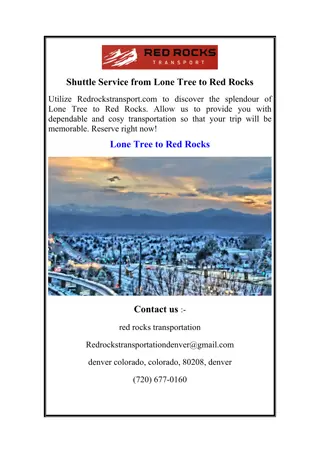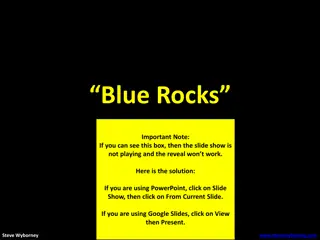Explore the Hidden World Beneath Your Garden: Soils and Rocks
Discover the fascinating underground world of soils and rocks in your garden. From minibeasts to plant roots, water filtration to bedrock layers, this article uncovers the secrets beneath your feet.
Download Presentation

Please find below an Image/Link to download the presentation.
The content on the website is provided AS IS for your information and personal use only. It may not be sold, licensed, or shared on other websites without obtaining consent from the author. Download presentation by click this link. If you encounter any issues during the download, it is possible that the publisher has removed the file from their server.
E N D
Presentation Transcript
Soils and rocks You might be surprised by what you find in your garden if you do a little digging... Below the grass and plants is an underground world of soil, stones, plant roots and animals!
In the soil Soil provides a habitat for many minibeasts and other living organisms. You will find earthworms, insects, bacteria and fungi here.
In the soil Soil contains plant roots, water, air and stones of different sizes, colours and textures. It acts as a filter for rainwater, cleaning it as it trickles through.
Soil profile Soil is arranged in layers. We call these layers the soil profile. Each layer has it own characteristics.
Bedrock Below the soil is a solid layer of rock called bedrock, or parent rock. Bedrock is the solid part of the Earth s crust. The depth of bedrock varies from place to place, but it can be up to 70 km!
Parent material Just above the bedrock is a layer in the soil profile called the parent material. This consists of broken-down, loose pieces of rock. Not much lives down here apart from the roots of very tall trees. Parent material
Subsoil Above the parent material is a layer called the subsoil. This is made up of sand, silt, clay, tiny rock fragments and minerals. Only a few plant roots are found here. Subsoil
Topsoil Above the subsoil is a layer called the topsoil. There is plenty of activity in this layer. The roots of most plants grow here and some animals make this their home. Topsoil consists of sand, silt, clay and humus. It also contains water and air, which support life.
Humus On the surface of the soil is a thin layer of dark-coloured decaying plant and animal material called humus. This gets mixed down into the topsoil by burrowing earthworms. It provides nutrients to growing plants through their roots.
Fertile soil Soil is vital for the growth of plants and crops. Good, fertile soil provides plants and crops with all the nutrients they need. It is important to look after the soil and protect our green spaces.
Soil dependency All of our food except for seafood is dependent on soil for growth. Not only do we eat edible plants, but our livestock relies on plants for food too.
Soil for farming The best soil for farming has a crumbly, sandy texture Crops planted in good soil grow fast, produce a high yield and contain plenty of nutrients.
Examining soil and rocks You can examine the texture of soil samples by crumbling them between your fingers. You can use a magnifying glass to examine the texture and appearance of both soil and rock samples.
Examining soil and rocks If a rock sample has a rough grainy texture, it is possibly sandstone. If it contains plant or animal fossils, it is most likely limestone. If it contains visible crystals, it is possibly granite.
Rock colour You can tell a lot about rocks by their colour. Be sure to wash the rock samples before you examine them.
Rock colour Here are some common rock colours and types: o black basalt o grey or tan limestone o light brown or darker reddish brown sandstone o speckled white or pink and black granite
Hardness of rocks You can easily examine the hardness of rock samples by scratching the surface of each. Use your fingernail first, then a paper clip, a coin, a metal nail file, etc. Remember to record your findings!
Illustrations Shutterstock Beehive























